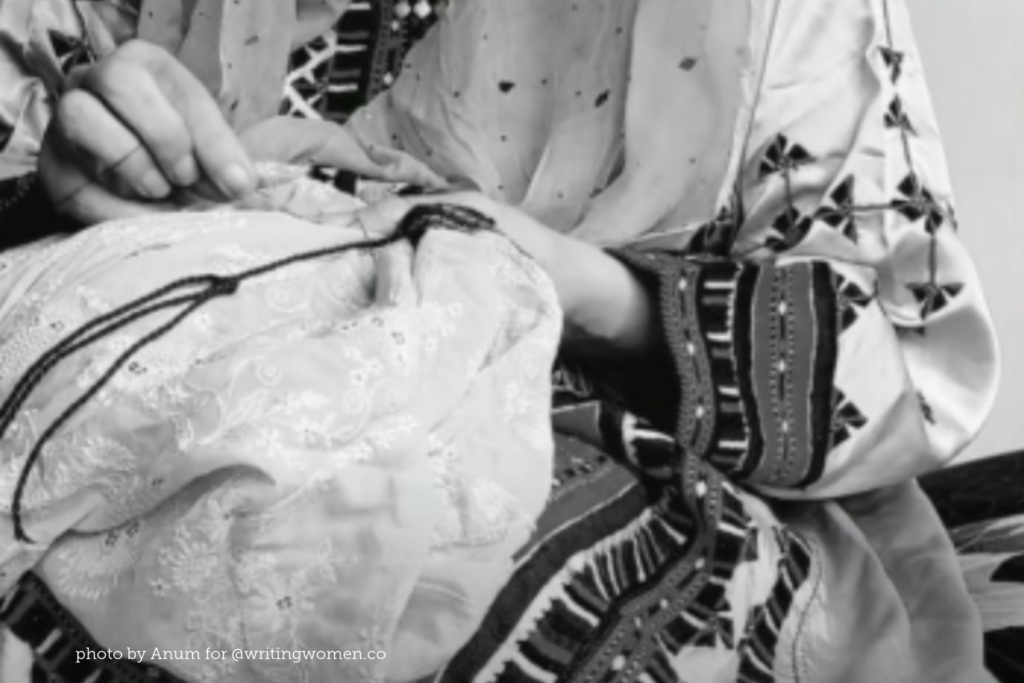Thread by thread, the intricate art of embroidery in Baloch society unfolds a profound language of identity, resistance, and belonging. Balochi embroidery is an ancient creative practice that sustains through collaborative participation. It not only celebrates individual artistry, but also translates into deeper threads of communal unity that structure social relationships across the region.
Women are central to this practice, they come together – friends, family, some visiting from neighboring areas – and sit together to embroider. They laugh, sing songs, exchange stories, share advice, and even burdens. Though they may fight, they still manage to overcome their differences. They are praised for their level of skill, and it adds to a sense of pride. It’s a skill that women take with them when they marry another in the Baloch community. They keep going back to it, whenever they get a chance, carrying a small cloth bag containing all their work. Women often embroider for themselves, especially unmarried aunts, who show their love and compassion through garments made for their loved ones.
Embroideries have changed over time because when they sit together, women invent new designs that translate into new styles. To understand how this knowledge is translated from generation to generation we can look to mothers who teach their daughters, and so on. Girls start learning as early as eight years, and women continue the craft until their eyes can no longer allow them.
Once free from domestic and employment responsibilities, they use their skills to add beauty to their lives. Once a woman has learned to embroider, she can use her skills to create and transform designs. With a plethora of surface materials, designs, and colors to choose from, she can create a piece perfectly suited to her needs. The motion of the needle moving upward and then coming down, filling the space with parallel lines closely placed next to each other, is similar to the relationship that exists between binaries; it is always an exchange, a back-and-forth, existing together. Sometimes you cannot see the other side, but it very much exists, holding its own sovereignty.
The intricate hand-embroidery is not only decorative, but is meant to be incorporated into daily life, accompanying the wearer in everyday moments. A front pocket to hold essentials, a bodice pinched at the sides to offer support, the flowy frock designed to stay put even on windy days and wide sleeves made for ease while tending to daily chores. It reflects the life of its maker, translating her thoughts, and feelings when she was weaving it, all that she is made of: the mountains, the barren land, her soul’s highest calling, and overwhelming feelings of love and grief. Allowing the needle to pass through serves as a therapeutic activity to release negative emotions, and gain a feeling of belonging, all while admiring the level of perfection she has achieved. Finding respite in the fact that when she is gone, her work will stay with her beloved, a loving legacy, accompanying them in times of need. Perhaps she doesn’t have the wealth to lavish her daughter with camels and extravagance, but she can offer comfort through skill, love, and passion. When locking the neckline, she thinks of her daughter’s delicate neck, and all the times she had kissed it to sleep.
The imperfection in her work draws attention to her growth as an individual as she aspires to become a free woman, passionately involved in her creation. Each time a new color scheme is invented or a mirror is added, she allows herself to take up more space. To live, there is a need to abide by the laws of necessity and free expression. You will not see flowers or smooth edges in her work; here, all the symbols are pointy, and the colors reflect those of its surroundings – earthy and warm. Years later, when you find a patch of her work, what you see is not an antique, or a collectible, but a reflection of her egalitarian life. It reflects all that it has lived through to fruition and how it decayed, showing how the artist stole time every day to fill the frames with colors. It encompasses everything her life entailed – her relationships, the earth, the breaths she took.
The symbols sprayed across the garment date back to the Mehrgarh civilization, one of the oldest in the region, indicative of how much it has survived. Upon closer inspection, it reveals a singular expression of life. It is this wholeness, the life of all, that allows the artist to make a place in this world. The complex interplay of expression and functionality exists on all spectrums: the future and the past, the industrial machine and the artisanal tool, rigid lines. In the current era, when embroidered pieces are being churned out by machines in less than a fraction of the time, the monetary price of a machine-made embroidered piece is nothing compared to what an original piece would cost. For anyone who wants to embody this art, they must be able to comprehend all that it entails. It is not simply about utility and expression but the translation of energy, spirituality, history, and embodied life as a whole.


